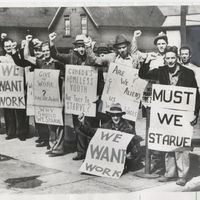Conclusion
In this project we have used Judith Robinson’s fonds as a lens to analyse how the homelessness crisis during the Great Depression and how the lack of government support to address this crisis led to the creation of John Frank’s House. John Frank’s House strived to not only provide homeless Torontonian men with food and shelter, but also with job skills and an education to equip them to maintain a stable career. Judith Robinson’s coverage on John Frank’s House and her insistence for her readers to donate to it, brought the homelessness issue more into the public eye and provided support for the men at the house. Moreover, the letters written to Robinson thanking her for her coverage on the homelessness situation and helping John Frank’s House exhibits that the government was not addressing the issue and alternative solutions to addressing homelessness like John Frank’s House were needed.
Although, the Great Depression and the homelessness caused by it was many decades ago, while doing this project, we have seen parallels between the homelessness issue of the Great Depression and the homelessness issue of today. In 2023, in the midst of inflation, housing is incredibly expensive, leaving many Canadians without stable living situations. Estimates conclude recently that around 150,000 to 300,000 Canadians will undergo homelessness each year. (14) Notably, the lack of government aid for the homeless during the Great Depression can also be seen today. From the lack of government assistance to provide affordable housing to the lack of government programs that help those with mental health needs, the Canadian government plays a huge role in perpetuating the severity of the homelessness crisis within the nation. (15) Therefore, we ask — will helping the homeless be similar to the Great Depression in that it was up to individuals like Judith Robinson and organisations like John Frank’s House to aid homeless Canadians or will the government step up and address the homelessness crisis?

